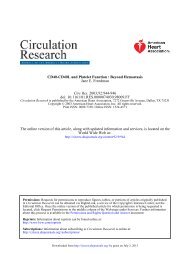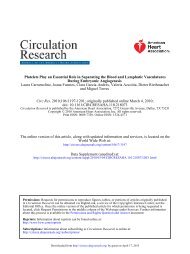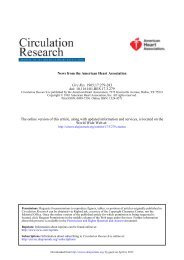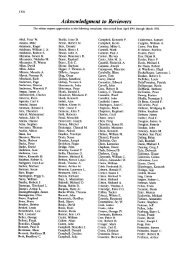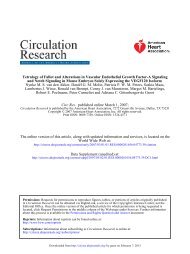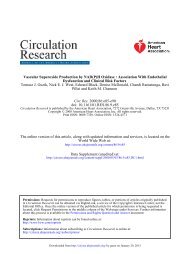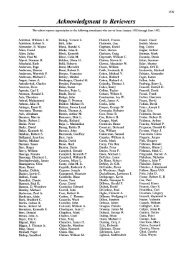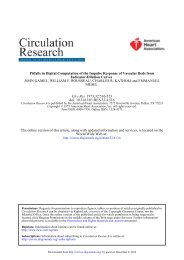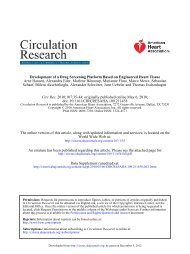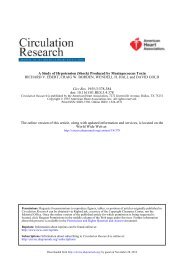Role of Sarcoplasmic Reticulum in Arterial Contraction: Comparison ...
Role of Sarcoplasmic Reticulum in Arterial Contraction: Comparison ...
Role of Sarcoplasmic Reticulum in Arterial Contraction: Comparison ...
You also want an ePaper? Increase the reach of your titles
YUMPU automatically turns print PDFs into web optimized ePapers that Google loves.
100 mg<br />
Caffe<strong>in</strong>e<br />
10 mM<br />
Ashida et al Ryanod<strong>in</strong>e, <strong>Sarcoplasmic</strong> <strong>Reticulum</strong>, and <strong>Arterial</strong> <strong>Contraction</strong> 857<br />
-Ryanod<strong>in</strong>e 10 pf<br />
-OCa-<br />
-12 mM Na / 138 mM NMG-<br />
Caffe<strong>in</strong>e<br />
10 mM<br />
Caffe<strong>in</strong>e<br />
10 mM<br />
Additive effects <strong>of</strong> calcium channel blockers and<br />
ryanod<strong>in</strong>e on NE-<strong>in</strong>duced contractions <strong>in</strong> rat aorta.<br />
Calcium channel blockers, which are known to block<br />
some receptor-operated channels 7 - 28 as well as voltagegated<br />
calcium channels 7 ' 29 <strong>in</strong> vascular smooth muscle,<br />
almost completely abolished contractions evoked by<br />
potassium depolarization (e.g., Figure 7 and below).<br />
In contrast, even high concentrations (10-30 \iM) <strong>of</strong><br />
§ 100 - •<br />
c<br />
>d I<br />
trol<br />
Is<br />
1 O<br />
• 50<br />
eplnephi<br />
o<br />
z<br />
(Perce<br />
n<br />
-<br />
-<br />
•<br />
V<br />
8R I V<br />
Ca Channels<br />
• i<br />
0.01 0.1 1<br />
Ryanod<strong>in</strong>e (pM)<br />
Oftlizam NMrendfekn Vaf<br />
10 yM 10 CM 10 CM<br />
FIGURE 4. Dose-response curve show- <strong>in</strong>g effect <strong>of</strong> ryanod<strong>in</strong>e<br />
on norep<strong>in</strong>ephr<strong>in</strong>e-evoked contraction tension <strong>of</strong> rat thoracic<br />
aortic r<strong>in</strong>gs (•). In the presence <strong>of</strong> a maximum concentration<br />
<strong>of</strong> ryanod<strong>in</strong>e (10 pM), a number <strong>of</strong> the preparations were<br />
exposed to verapamil (a, n = 3), diltiazem (o, n = 5), or<br />
nitrendip<strong>in</strong>e (A, n=2), as <strong>in</strong>dicated on right-hand side. *,<br />
mean ± SEM for n<strong>in</strong>e preparations. NE concentrations were<br />
2-6 x W M. Rest<strong>in</strong>g tension, 500 mg. Results suggest that<br />
norep<strong>in</strong>ephr<strong>in</strong>e contraction can be divided <strong>in</strong>to three components:<br />
1) a ryanod<strong>in</strong>e-sensitive component, 2) a component due<br />
to calcium entry from the extracellular fluid via calciumselective<br />
channels (i.e., it is blocked by three types <strong>of</strong> calcium<br />
channel blockers), and 3) an unidentified component (?) that is<br />
due to neither calcium release from SR nor calcium entry via<br />
calcium channels. Latter component accounts for 10-20% <strong>of</strong><br />
NE-<strong>in</strong>duced contraction. See text for further details.<br />
Caffe<strong>in</strong>e<br />
10 mM<br />
FIGURE 3. Ryanod<strong>in</strong>e-<strong>in</strong>duced tension <strong>in</strong>crease<br />
<strong>in</strong> 0-calcium (0-Ca), low-sodium (low-<br />
Na) solution, rat aortic r<strong>in</strong>g. After stabilization<br />
and caffe<strong>in</strong>e control contraction <strong>in</strong> Krebs solution,<br />
tissue was perfused for 30 m<strong>in</strong>utes with<br />
a 0-calcium, 1.2-mM-Na, 138-mM N-methylglucam<strong>in</strong>e<br />
solution, without change <strong>in</strong> basel<strong>in</strong>e<br />
tension. Addition <strong>of</strong> 10 \LM ryanod<strong>in</strong>e led to a<br />
slow but marked <strong>in</strong>crease <strong>in</strong> tension that was<br />
reversed rapidly by restoration <strong>of</strong> a normal<br />
sodium gradient <strong>in</strong> spite <strong>of</strong> the cont<strong>in</strong>u<strong>in</strong>g<br />
presence <strong>of</strong> ryanod<strong>in</strong>e. Caffe<strong>in</strong>e contraction<br />
was completely blocked by ryanod<strong>in</strong>e (only<br />
relaxation was seen) but was fully restored<br />
after 2 hours <strong>in</strong> ryanod<strong>in</strong>e-free Krebs solution.<br />
There was a 35-m<strong>in</strong>ute <strong>in</strong>terval between the first<br />
and second section <strong>of</strong> the trace and 110 m<strong>in</strong>utes<br />
between the second and third section. Rest<strong>in</strong>g<br />
tension, 500 mg.<br />
the calcium channel blockers reduced NE contractions<br />
<strong>in</strong> rat aorta by less than 50%. 2 Comb<strong>in</strong><strong>in</strong>g ryanod<strong>in</strong>e<br />
with a calcium channel blocker had an additive effect<br />
and suppressed contractions to a much greater degree<br />
than did either <strong>in</strong>hibitor alone (Figures 4, 5, and 7).<br />
Nevertheless, a small portion <strong>of</strong> the NE-<strong>in</strong>duced<br />
contraction was <strong>in</strong>sensitive to high concentrations <strong>of</strong><br />
ryanod<strong>in</strong>e and the calcium channel blockers but was<br />
dependent on external calcium (not shown).<br />
Sources <strong>of</strong> trigger calcium <strong>in</strong> bov<strong>in</strong>e tail artery.<br />
Morphological data 910 - 30 <strong>in</strong>dicate that there is large<br />
variation <strong>in</strong> SR content between different vascular<br />
smooth muscles: more peripheral vessels may have<br />
much less SR than do the large conduit vessels. We<br />
studied the bov<strong>in</strong>e tail artery, which is similar <strong>in</strong><br />
diameter to the rat aorta, to explore the functional<br />
correlates <strong>of</strong> these morphological observations.<br />
100r<br />
.-?>•<br />
,-- < + 10 |1M<br />
Ryanodln*<br />
' ••• . '<br />
0 pU<br />
nodln*<br />
0 pM<br />
WH.r <strong>in</strong>dlclix<br />
N o r a p l n a p h r l n a < H )<br />
10" 10'<br />
FIGURE 5. Effect <strong>of</strong> 10 \iM ryanod<strong>in</strong>e and 10 \iM nitrendip<strong>in</strong>e<br />
(<strong>in</strong> presence <strong>of</strong> ryanod<strong>in</strong>e) on norep<strong>in</strong>ephr<strong>in</strong>e dose-response<br />
curve <strong>of</strong> rat aortic r<strong>in</strong>gs.<br />
Downloaded from<br />
http://circres.ahajournals.org/ by guest on April 6, 2013




